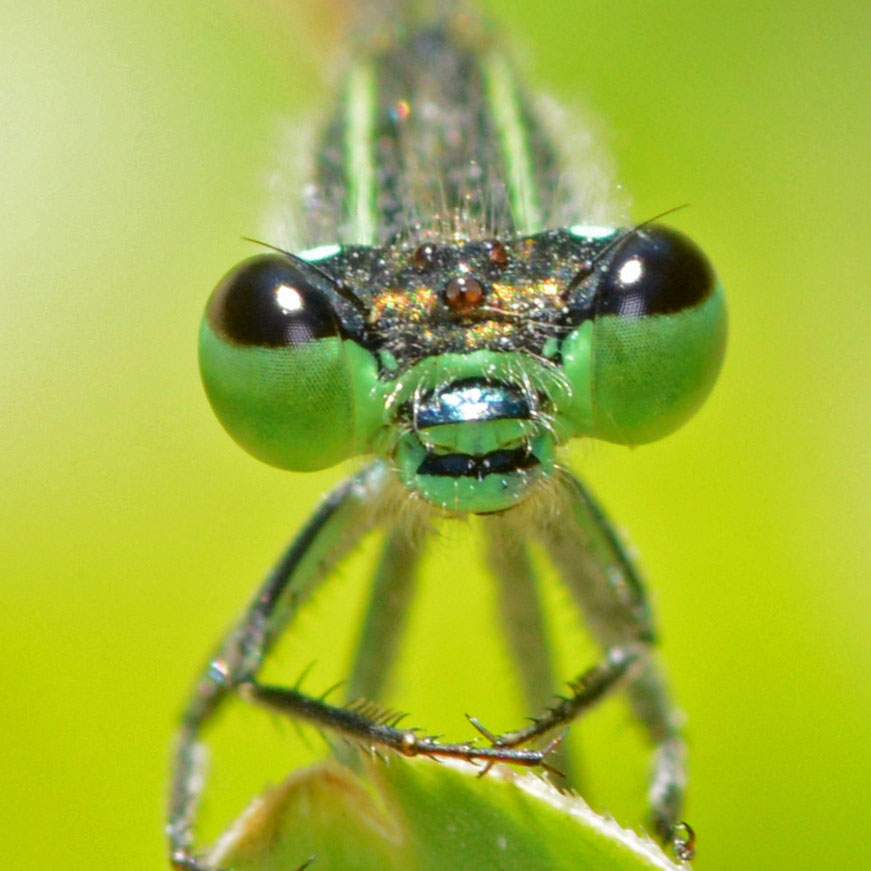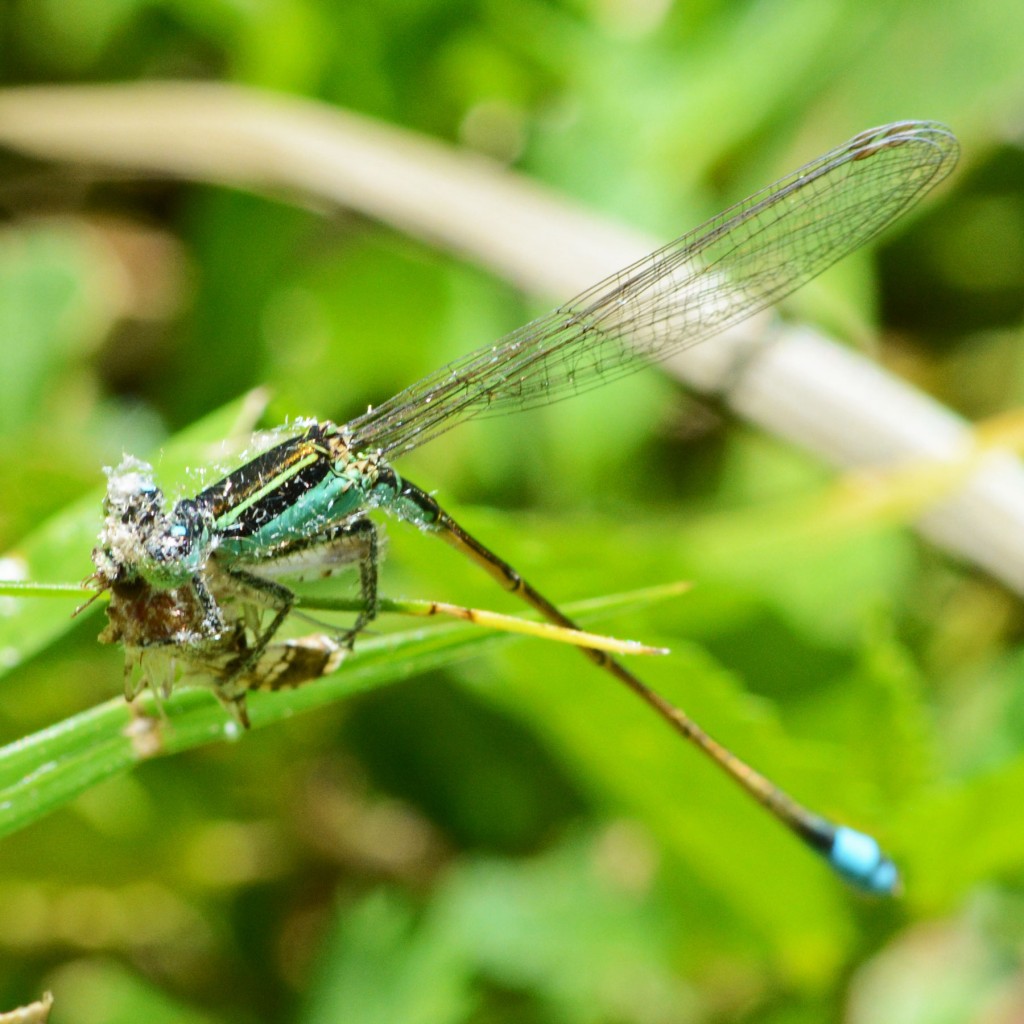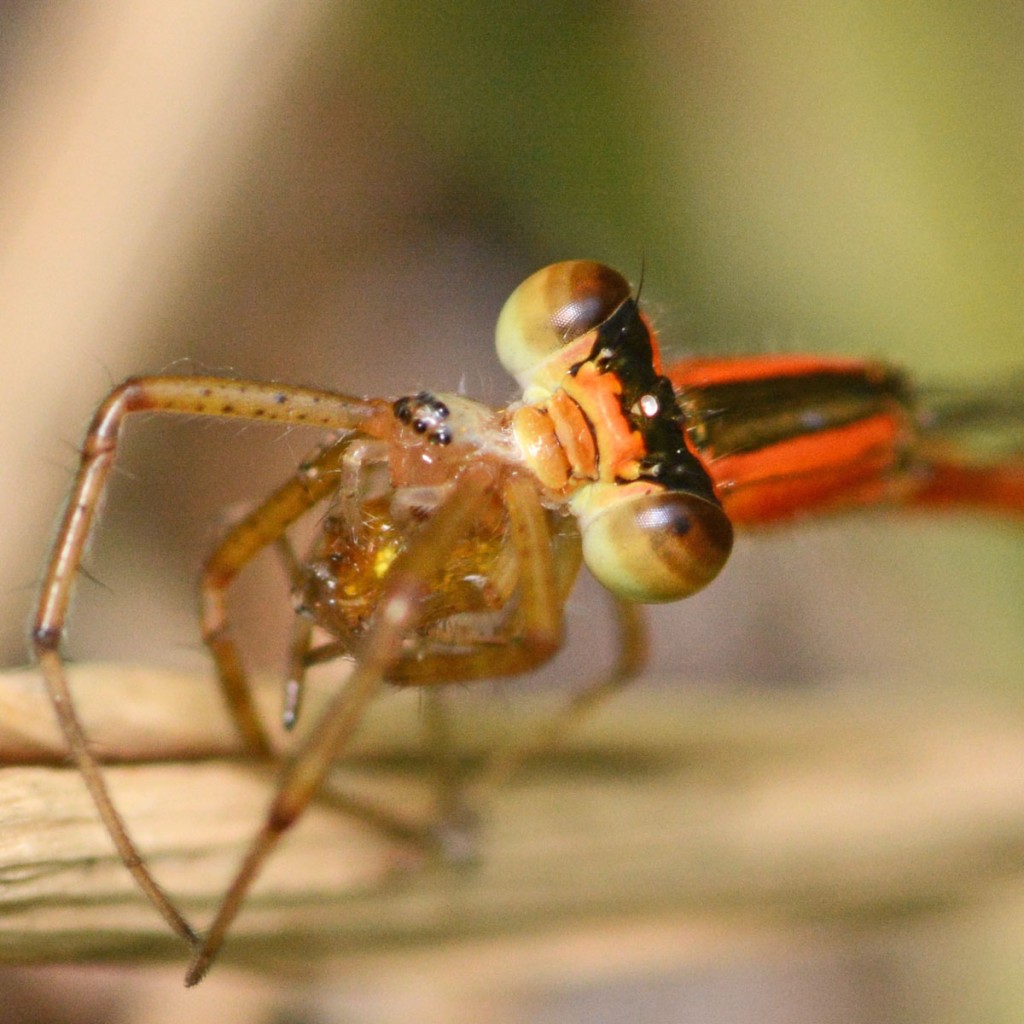Fair’s fair: since I made a face map of the dragonfly last week, I need to do the same for the damselflies. For those of you who aren’t hip to the differences between these two suborders of Odonata, one easy way to remember it is think of dragons and damsels. Dragons are large, damsels are dainty.
Other differences include
- Posture: dragonflies hold their wings out to the sides when they perch, while damselflies fold them over their backs, parallel to the axis of their body.
- Head structure: Dragonfly eyes are so large that they don’t have a “top of the head”; instead their eyes meet along the occipital seam where the top of their head would be. Damselfly eyes, while still quite large, are separated by the braincase externally as well as internally.
- Wing structure: If you’re up to a bit of taxonomic Latin, another difference between the two suborders of Odonata can be found in their names: Anisoptera, the dragonfly suborder, means “unequal wing,” because their forewings and hindwings are shaped differently; Zygoptera, the damselfly suborder, means “joined or paired wings” and, as the name implies, the two pairs of damselfly wings are similar in shape.
Also, dragonflies eat damselflies from time to time. (And so do damselflies; I’ve not heard of damselflies eating dragonflies, but I haven’t searched the literature at all.)
So anyway, here’s the face map of the damselfly, courtesy of the ubiquitous Rambur’s Forktail (Ischnura ramburii). Mouse over the image to get the labels.

If you were wondering about the visual acuity of damselflies with their eyes being so much “smaller” than those of their cousins, don’t. They can see incredibly well. Here’s another Rambur’s Forktail making a lunch out of some hapless moth it happened to grab as it was trying to avoid the approach of my camera:

As you can see, the successful predation comes at a cost: now the damselfly is coated in scales (remember that moths are in the order Lepidoptera, which translates to “scaly wing”) from its lunch. Presumably it will have to undergo some extended grooming sessions later on to remove all that debris. But for right now: yum! (If you refer back to the image at top, you’ll see that the legs have a series of spurs along them that aid them in capture of aerial prey. They end in a sort of v-shaped structure called the tarsal claw; that’s what they use when cleaning their faces.)
While damselflies aren’t as robust as their large cousins, the dragonflies, they’re no slouches when it comes to the eat-or-be-eaten game that all life on this planet participates in. The other day, as I was trying to get a good picture of a damselfly face to use on this post, I observed this young female Citrine Forktail (Ischnura hastata):

I was chasing her from perch to perch to get the best angle for the photo, and at one point I noticed a spider drop from a blade of grass as if to attack her. They both disappeared under the tall grass, and I dug around in there with my hand, ripping out blades of grass, in an attempt to see what was going on. I’d seen lots of dragonflies trapped in spiderwebs before, but this was the first time I’d seen a spider make a jumping attack on a damselfly. I felt awful; my quest for a beautiful photo had ended in the untimely demise of this beautiful orange jewel.
Turns out, I had misinterpreted the interaction. The spider wasn’t so much jumping out of the grass to attack the damselfly as it was falling out of the grass in a desperate attempt to avoid the damselfly. And without success. Here she is after I cleared away the obscuring grass stems, glaring balefully at me for disturbing her meal:

In the shot above, it’s hard to tell what kind of spider this is. I suspect, based on all the silver visible in the shot below, that it’s one of our two common Argiope species, either Silver (A. argentata) or Florida (A. florida), but I don’t know how to tell for sure:

If any of you are able to ID that spider from the belly and head shots on this site, please let me know what it is!
Anyway, hope you enjoyed this brief romp through damselfly facial anatomy nearly as much as I did.
References
Corbet, P. (1999). Dragonflies: Behavior and Ecology of Odonata. Ithaca: Cornell UP
Westfall, M. J. Jr. and M. May (2006). Damselflies of North America, Revised Edition. Gainesville: Scientific.
Paulson, D.R. (2011). Dragonflies and Damselflies of the East. Princeton, NJ: Princeton UP.
